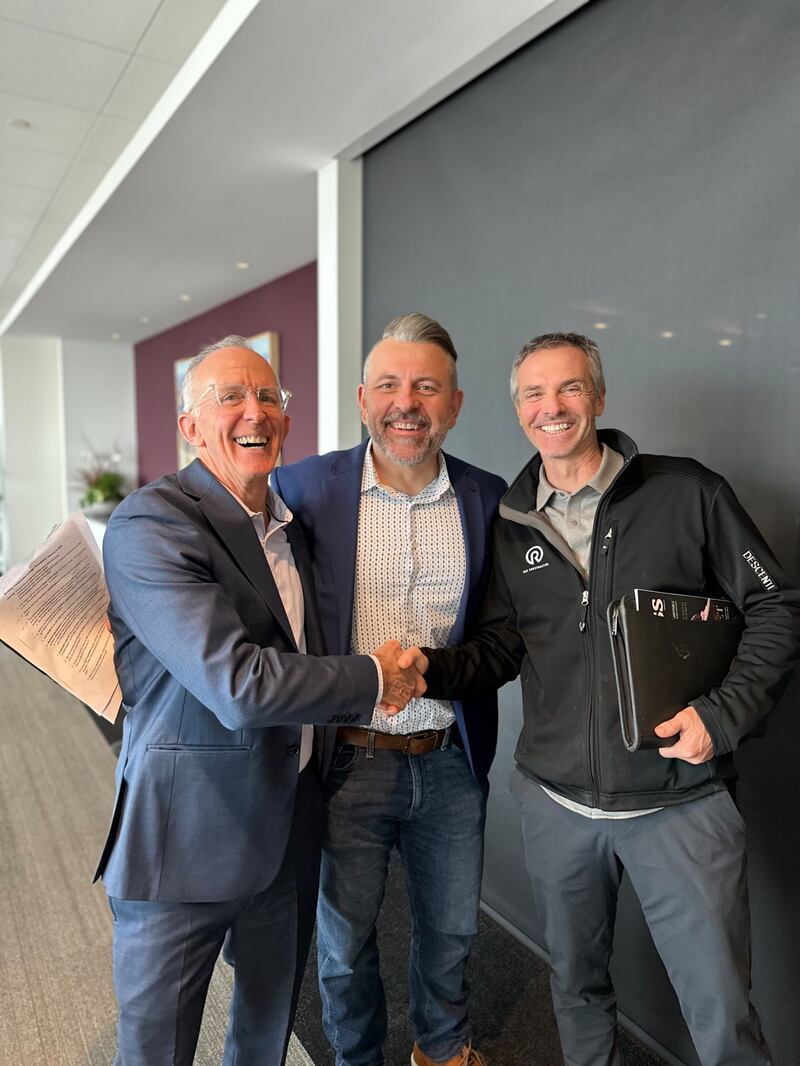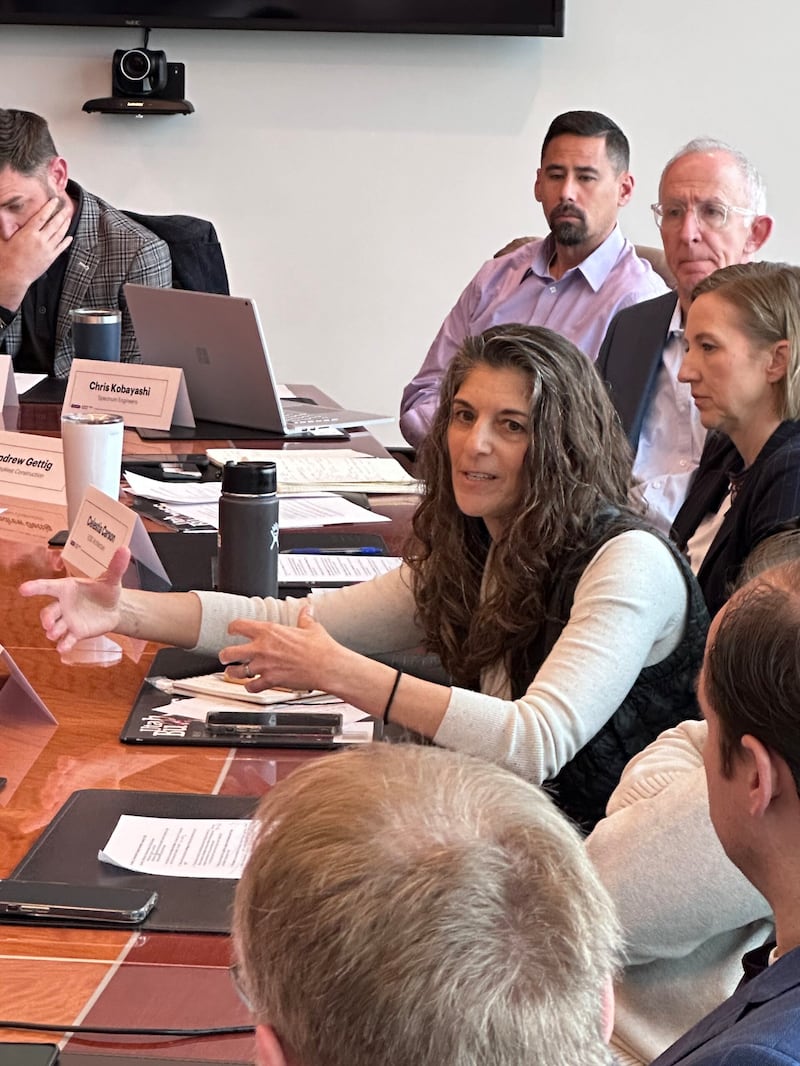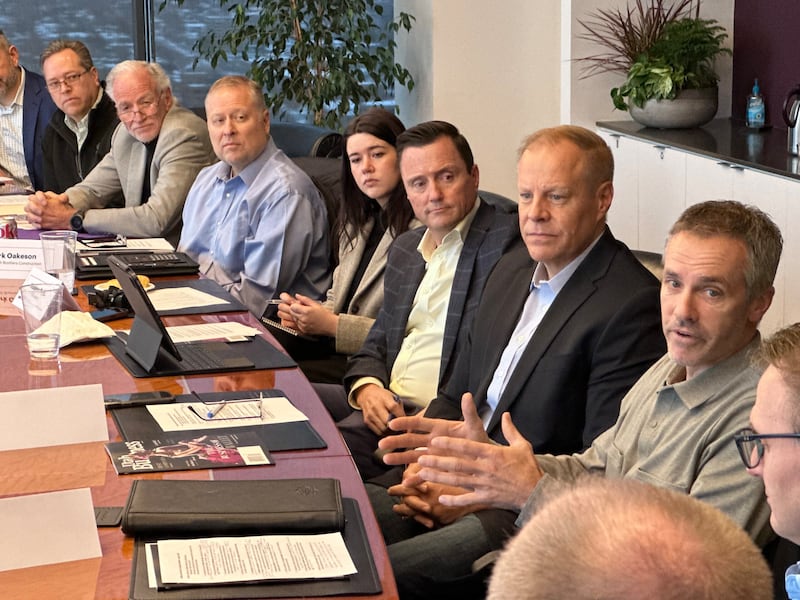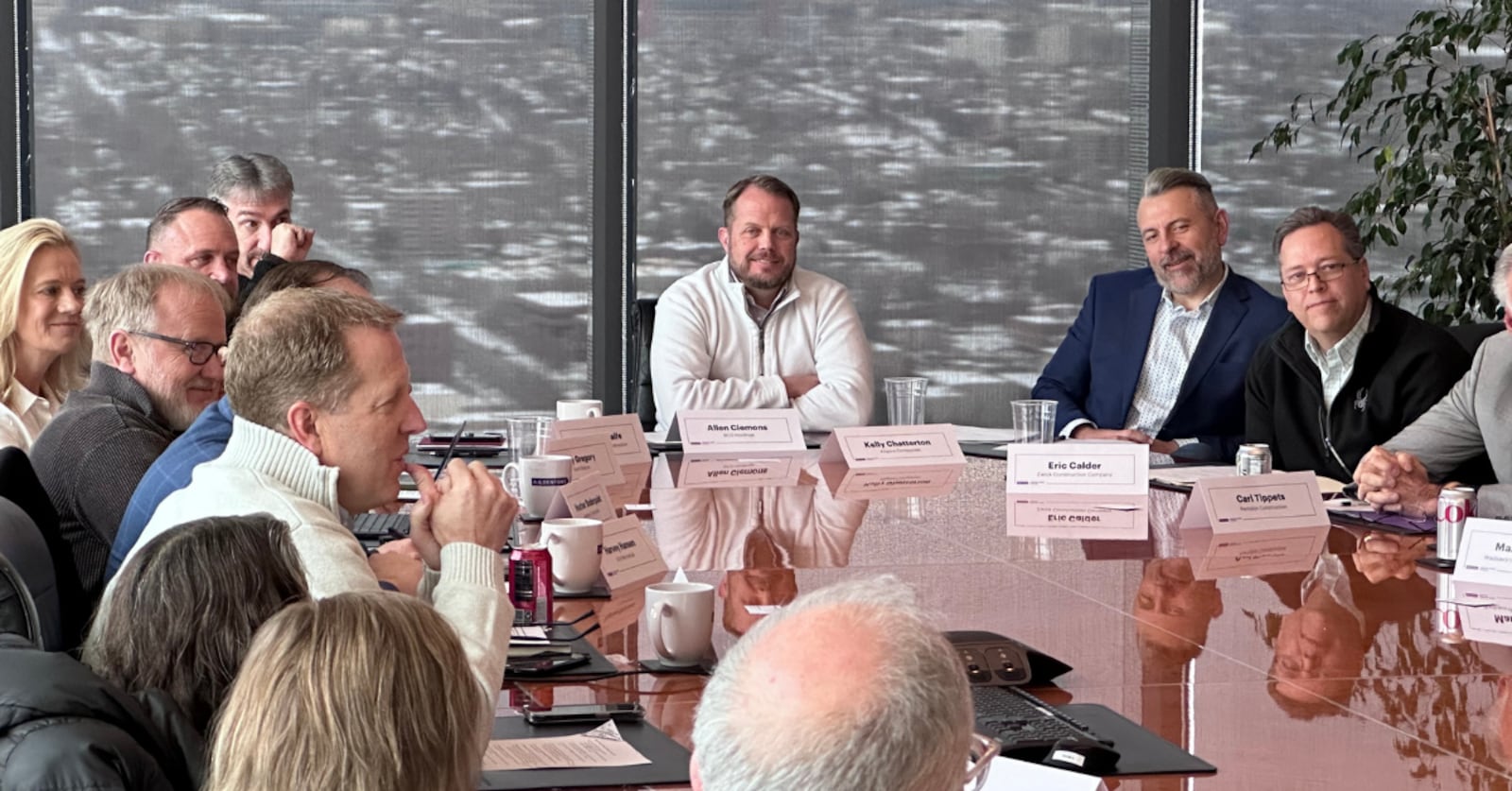Last month, Utah Business partnered with Dentons Durham Jones Pinegar to host a roundtable on the state of building, construction and design in Utah. Moderated by Joey Gilbert, president and CEO of Associated General Contractors of Utah, they discussed workforce demands, mental health, innovations and more.
We’ve heard it’s a great time to be in construction. Is that true?
Aaron Metcalfe | VP, Marketing & Business Development | Hogan & Associates Construction
For the people in the field, it’s a great time because their salaries are going up due to market forces. A good superintendent is worth their weight in gold. How it translates for the ownership and things like that is debatable. Owners get a quality building if they have a good superintendent and good crews, but higher costs are going to slow down the market.
Mark Oakeson | Commercial Division Manager | Wadsworth Brothers Construction
We’re seeing a split between publicly and privately funded projects. It’s a good time to be a firm pursuing diverse projects because the privately funded stuff is struggling to get started. The cost impacts are felt harder by private owners. However, good publicly funded projects are coming down into states with a lot of growth, like Utah.
Jeff Palmer | EVP | Layton Construction
An old friend from the tech industry called recently asking if I was hiring. I’ve lost many employees over the years to tech companies, so it’s fun to hire someone from tech. I’ve had three phone calls like that. When the tech industry is reaching out to the construction industry, it’s a good time to be in construction.
Keith Hansen | Architect & Partner | AE Urbia
We’re just as busy as we’ve been the past 10 years, and there are a lot of projects coming online. The design side of things has not slowed down. There are build-to-suit office buildings, multi-family projects and even a one million-square-foot warehouse out in the northwest quadrant coming on board. They may not build right away, but they’re ready to pull the trigger as soon as it makes sense for them.
Chris Kobayashi | Principal Electrical Engineer | Spectrum Engineers
We’re seeing an extension of design timeframes in general. It’s not just, “Go and do the design.” We’re doing all the pre-construction, responding to costing and going through iteration after iteration. Projects that might’ve been a six- or nine-month design are now a nine- or 12-month design.
Carl Tippets | President | Pentalon Construction
Construction costs are 30 percent higher than they were pre-pandemic. Interest rates are very, very high right now. Loan-to-value ratios have all become pretty punitive. The small people who wanted to do projects are really being pushed out. The real reason larger developers push forward is that they’ve built a lot of overhead and have to justify that by finding projects.
What’s keeping you up at night?
Troy Gregory | President & CEO | Hunt Electric, Inc.
The challenges moving forward are the mega projects coming down the pipeline: Texas Instruments, massive data centers, etc. Those projects have money built into them, and it’s going to be an issue. We don’t want to tie all of our resources up in those projects and not be available for others.
Harvey Hansen | President | KOH Mechanical Contractors
Manpower is going to be the biggest issue with these projects all coming up. We’re reaching out to high school students before they’re even in the trade, telling them that there are other things besides college. We’re reaching out to counselors to show them that trade schools allow for good living.
Heather Soderquist | VP, Construction Innovation | Jacobsen Construction
What we’re dealing with is the balance between our young people and our experienced people. We have a lot of young people out there who are eager and ready to go with no experience. We are constantly trying to balance keeping up with construction, educating young people and putting practices in place fast enough.
Kelly Chatterton | VP | Utah Ready Mix (representing Kilgore Companies)
Our challenge is to stay competitive from a wage standpoint while facing pressure to keep projects. We help train the younger workforce and show them that this is a good career path, but the cost to train now under the new standards is challenging.
Braden Moore | VP | Big-D Construction
We are making sure we’re spending time on the right projects, providing great customer service and mitigating risk along the way for ourselves and our owners. If you’re not mitigating risk in pre-construction, you’re going to have huge issues in construction.
What are you doing to attract younger generations into construction and bring women into the industry?
Aaron Hall | Director, Operations | Okland Construction
This isn’t something the industry is going to solve for us. We have three main focuses: recruit, train and retain. We have a committee focused on presentations and visits to high schools, summer short-term internships and paid scholarships for the next generation of our craft. We’re also focused on compensation, benefits and giving young professionals training and a career path.
Troy Gregory | President & CEO | Hunt Electric, Inc.
We’ve had a lot of success getting students from high schools. We’ve narrowed in and put it into certain channels to help them get going quicker and develop further with the necessary skill sets. We’re trying to give them the skills to help them be successful right out of the gate.
Celestia Carson | Principal | VCBO Architecture
The licensing body for architects is taking a very hard look at the barriers preventing people with talent and passion from becoming licensed architects, including opening alternative paths to licensure. This will start bringing in people who have the ability to be licensed architects but not the funds. Also, it’s hard for anyone to be what they don’t see. As we’ve brought more women into partnership, it’s amazing how many more women apply to become employees at our office.
Jodi Geroux | Director, Hospitality Studio | FFKR Architects
At FFKR, we’ve implemented maternity and paternity leave benefits to bring in and retain women and men. We are a very family-oriented company and understand that we all have families and friends outside of work—we really strive to hit a work/life balance. We encourage people to take time off when they have time off and spend it with their families.
Allen Clemons | Design, Real Estate Development & Construction Industry Consultant | Sequel Development
We created an Industry Advisory Committee Scholarship at BYU that funds 20+ scholarships every year for students in construction management. Almost 50 percent of the scholarships in the last few years have been either minority-received or women-received.
Andrew Gettig | General Manager & Senior Commercial Account Manager | Sports West Construction
Some of the young workers we hire think they’re going to be running the company in two years. They’re not interested in a 10-year career path. Corporate offices are trying to make their campuses more attractive with yoga studios, in-house theaters and rooftop pickleball. If we want to be truly innovative, we have to adapt at a leadership level. We need an actual plan that will help our people be as effective as they can.


How are you addressing work/life balance and mental health challenges?
Slade Opheikens | President & CEO | R&O Construction
Through my involvement in AGC [Associated General Contractors of America], I’ve become more aware of the mental health crisis in our industry. Our company recently brought in a health coach to help employees. What we do is so cool, but how are we going to get the next generation into construction if our employees are telling their kids it is too stressful?
Mark Oakeson | Commercial Division Manager | Wadsworth Brothers Construction
We’ve brought a lot of that on ourselves as a general contracting community. We’re always tripping over ourselves to please owners and our clients, but sometimes, that comes in the form of faster schedules and promises made during pre-construction. All that pressure gets pushed onto the field and causes the mental issues we’re talking about. I’m not suggesting I know what the solution is, but the source of the problem is us.
Eric Calder | VP | Zwick Construction Company
Our company focuses on teamwork and passion. If we can help people realize their goals or their interests outside of work, that is fantastic. I really enjoy being around people who are passionate about things outside of work so that I can be exposed to new things.
Aaron Metcalfe | VP, Marketing & Business Development | Hogan & Associates Construction
This is becoming an industry-wide issue that AGC could help organize. We’re on the downside of the baby boomers’ retirement wave, and the new generations want work/life balance. Even if they’re more inclined to STEM jobs, they have different attitudes. We’ve got to make it more exciting and easier to get them on that path.
Heather Soderquist | VP, Construction Innovation | Jacobsen Construction
Business is changing, and it’s changing fast. Start looking at your current processes and procedures and ask yourself why you do it that way. This industry is structured to have silos between the architect, the engineers and the contractors. We need to ask if we are truly collaborating. If we want to change this industry and move things to the next generation, we have to start back there.
Braden Moore | VP | Big-D Construction
We talk about teamwork a lot and then say a job can only have one superintendent—and they are out there by themselves. We create teamwork by telling owners what the job takes, period. We may not get the job, but we have to have this team, and it is the right size team for this job. If you aren’t upfront with owners, you’ll have people there by themselves. The quality and project will suffer.
Jodi Geroux | Director, Hospitality Studio | FFKR Architects
People need to feel our support and have an avenue to find help and mentorship. We implemented a mentorship program many years ago so people could have someone to go to. We encourage everyone at FFKR to ask questions and get support. The companies I’ve seen the most success with are the ones that provide their people with a clear path forward.
What exciting innovations are you seeing?
Celestia Carson | Principal | VCBO Architecture
I’m seeing a lot of technology on the job site. The tools we use have totally changed. When I went to architecture school, I learned how to hand draft. Now, everybody has the plans in their pocket on a phone—and in 3D. You work out the issues in real time. The buildings are more complicated, more complex, more technical.
Mark Oakeson | Commercial Division Manager | Wadsworth Brothers Construction
We’re inundated with software and project management packages. Our reputation is being noninnovative and nonchanging because we have boots on the ground. There are still people doing construction—hanging drywall, putting steel studs in. We need to adopt new software and technology, but we’re not going to just jump in and start implementing each latest fad. We want to see if it’s actually going to be useful before we integrate it.
Jeff Palmer | EVP | Layton Construction
We’ve always tried to embrace the newest technology. We’ve talked about burnout and the challenge of finding people to work in the industry; part of the solution is technology. As we incorporate technology, we’re solving the problems of depression, burnout and labor shortage. It’s also comforting knowing I work in an industry that won’t be replaced by AI. That’s part of the satisfaction of building something with your hands.
Keith Hansen | Architect & Partner | AE Urbia
There’s a lot of talk of keeping employees happy and training them—that’s all investment. The same thing goes for technology. If you commit and invest time and money in technology, it will move the industry forward. When Revit first came out, we had to invest a lot into training people on how to model a building in 3D, and now it’s standard. As technology progresses, the investment is required by everyone here.
Andrew Gettig | General Manager & Senior Commercial Account Manager | Sports West Construction
When I was a kid, the playground equipment was cemented into the parking lot. It was not a very safe place. In our industry, the innovations are safety, surfaces, shock absorption and not slippery when wet. On today’s playgrounds, if the kid’s going to be off the ground, they have to have a commensurate shock-absorbing pad underneath. They are using new material science, creating new solutions and applying those to where they make a difference every day.
Allen Clemons | Design, Real Estate Development & Construction Industry Consultant | Sequel Development
On one of our projects, there was an excavator fully controlled by GPS and a model. It’s almost like they’re managing the equipment rather than running it. Just around the corner from that project, we used GPR [ground-penetrating radar] to determine what the concrete and existing structures were made of. We’re utilizing lots of innovations; we just don’t recognize it enough.

What’s your overall outlook for the industry?
Slade Opheikens | President & CEO | R&O Construction
Aligning design with budget and owner needs is probably one of our biggest challenges right now because we still have owners trying to add all the fancy stuff they can’t afford. Maybe they can afford it in two or three years, but they can’t afford today what they had two years ago. It is a great time to build, but we have to change what our hopes, dreams and expectations are to fit what we can afford.
Harvey Hansen | President | KOH Mechanical Contractors
Mechanical equipment is still hard to get. I’m sure you guys deal with it on every single one of your jobs—you get promise dates, but the suppliers aren’t matching up. They still haven’t caught up. Another thing we’ve seen is that the flow has changed. I’ve got a job where we’ve already bought the air handlers and chillers, but we don’t even have a contract for the rest of the job. That’s the reality we live in right now.
Carl Tippets | President | Pentalon Construction
It’s a good time to be building, but the rules have changed. The design-bid-build is an antiquated system. Design-assist is a much better process. In today’s world, you need to finish pre-construction completely before you start construction. However, you can now start to procure equipment even before you reach a contract. You have to think through the process differently now.
Chris Kobayashi | Principal Electrical Engineer | Spectrum Engineers
If there is owner engagement, clarity and buy-in as a team member, things go well. Owners need to understand that they are members of the team, and they have to commit to being members of the team and hold their decisions. If they change a decision, they need to understand the implications of that. Things will be late and more expensive.
Aaron Hall | Director, Operations | Okland Construction
It’s a great time to build because things don’t get cheaper. This is the new norm, so let’s embrace where we’re at today. Let’s take the technology and solve the workforce problem. Let’s have better discussions with our owners. Let’s leverage teamwork and collaboration with technology. We’re not going to have what used to be, but we can have an amazing future as we embrace that.

